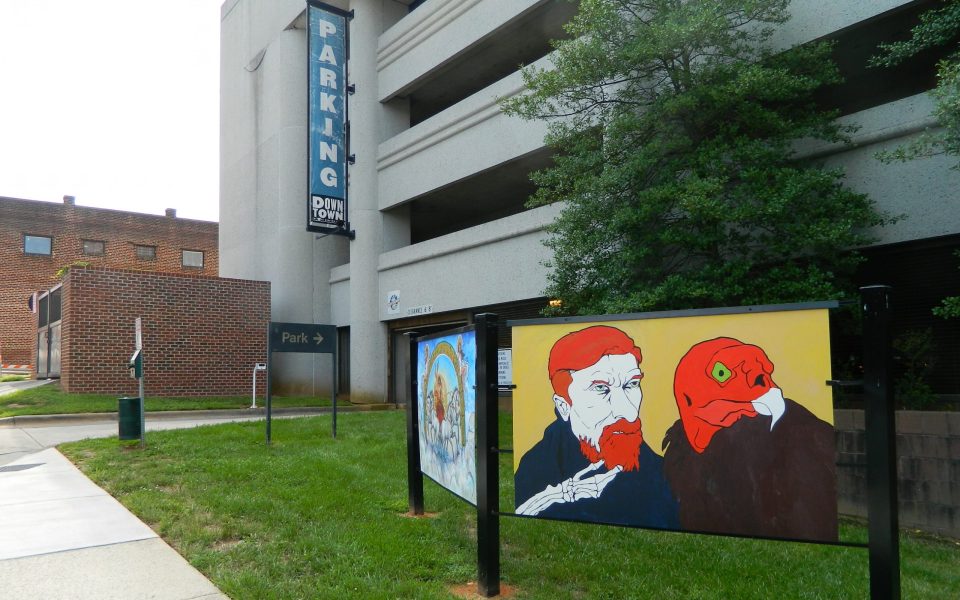by Eric Ginsburg
When Kelly Bennett thinks about potential sites for public art in Winston-Salem, the first thing that comes to mind is how to activate underused spaces and areas that aren’t even really thought of as a place.
“The one that I keep thinking of is the underpass on the downtown Strollway,” he said. “From downtown, it is south down to Salem Avenue and Salem Creek Greenway. It’s not a welcoming place to go under a highway. What some cities have done is transform that space through light, making it colorful or projecting something there.”
Bennett, a city planner, spends a lot of time thinking about public art in Winston-Salem and how it could improve the city, but he’s hardly the only one. Last week he presented a public art plan to a city council subcommittee and received overwhelming support, but Bennett wasn’t just acting out of his own fascination with public art.
The plan, which will be refined before appearing before the full city council for approval, is one element of Winston-Salem’s award-winning Legacy 2030 master plan, and it grew out of frequent feedback from residents who said they want to see more art.
“I’m working on this because it was in our plan, and it’s in our plan because so many people in the city, residents of the city, wanted to see more public art,” Bennett said. “Our entire department is reacting to this need in the city.”
Bennett wasn’t just assigned to tackle public art — he comes by the medium naturally. Both of his parents were art teachers, he studied art history in college and spent a decade working as a photojournalist, most recently for the Winston-Salem Journal. He planned to study arts conservation in school at the University of Delaware until being advised against it because he is colorblind.
Bennett was still drawn to urban planning even while pursuing art, reading books about cities in his leisure time.
“I always had this love of cities and figuring out why is this here, how do you make this work better, how do you make this city better,” he said.
His background made him a natural choice to lead the process to create a public art plan.
The city plan lays out options for public art, including partnerships with existing organizations, Bennett said. It would potentially create a public art commission that could facilitate more public art, helping organizations and artists navigate permissions and permits and assess the feasibility of a project.
“What it probably won’t do is recommend specific projects, but it could highlight opportunities like underpasses or greenways, parks and different types of art,” he said. “This would find opportunities for perhaps those organizations that are already doing public art or other organizations or individual artists who hadn’t considered doing public art saying, ‘Oh, maybe that’s something I want to pursue.’”
The body could look at how practical an idea might be, he said, using the concept of painting a crosswalk out of flowers on Fourth Street as an example.
“People have this idea that [public art] is a statue of somebody or it’s a mural,” Bennett said. “There’s a lot of public art out there so I just wanted to show what else it can be. It can be a mural, but it can also be a mural that uses vegetation on the wall to make a face. It can be practical like bus stops or bike racks, or art on utility boxes.”
There are plenty of examples of strong public art already in the city, Bennett said, mentioning murals on Trade Street and the Salem coffee pot that has become a local landmark. And Bennett has no trouble coming up with reasons why that’s important, including increasing tourism and attracting creative people to move to Winston-Salem.
“The way your city looks has a big value to it,” he said. “One of the ways that people are proud of their city is through public art. It’s these landmarks and monuments that make your city unique. When people are proud of their city, they invest in their city. They want to stay here and grow their businesses here. They’re not looking to the next place to move if they’re proud of their city.”
Join the First Amendment Society, a membership that goes directly to funding TCB‘s newsroom.
We believe that reporting can save the world.
The TCB First Amendment Society recognizes the vital role of a free, unfettered press with a bundling of local experiences designed to build community, and unique engagements with our newsroom that will help you understand, and shape, local journalism’s critical role in uplifting the people in our cities.
All revenue goes directly into the newsroom as reporters’ salaries and freelance commissions.




Leave a Reply